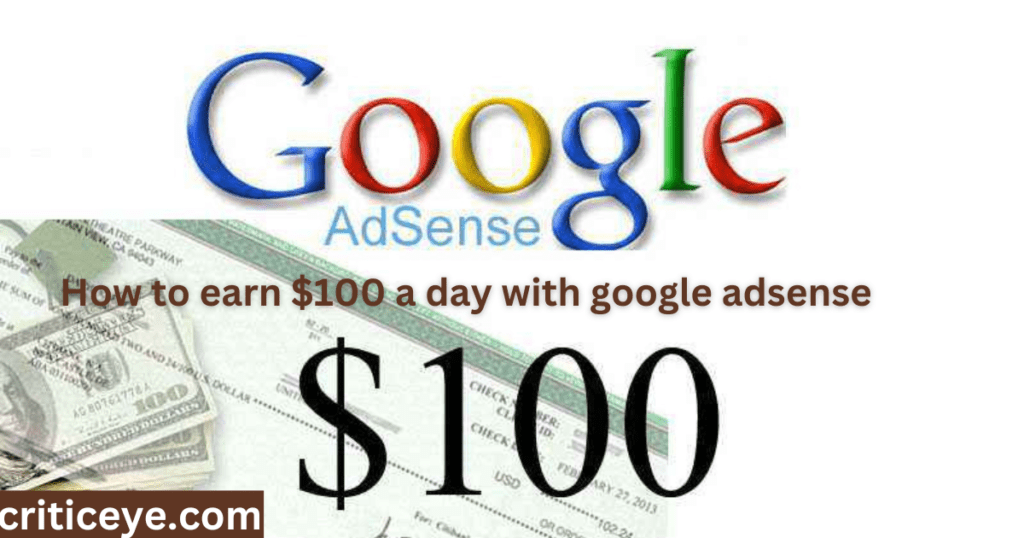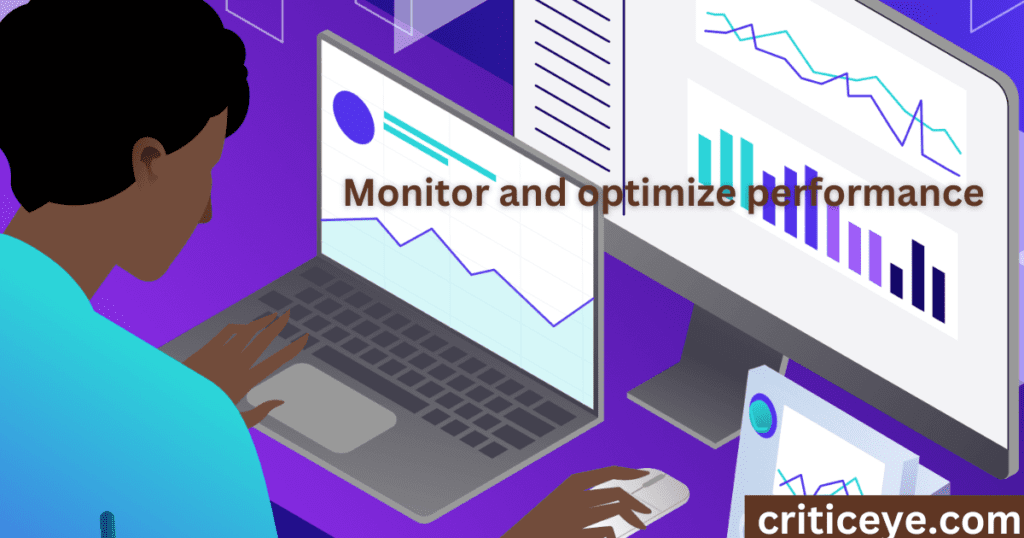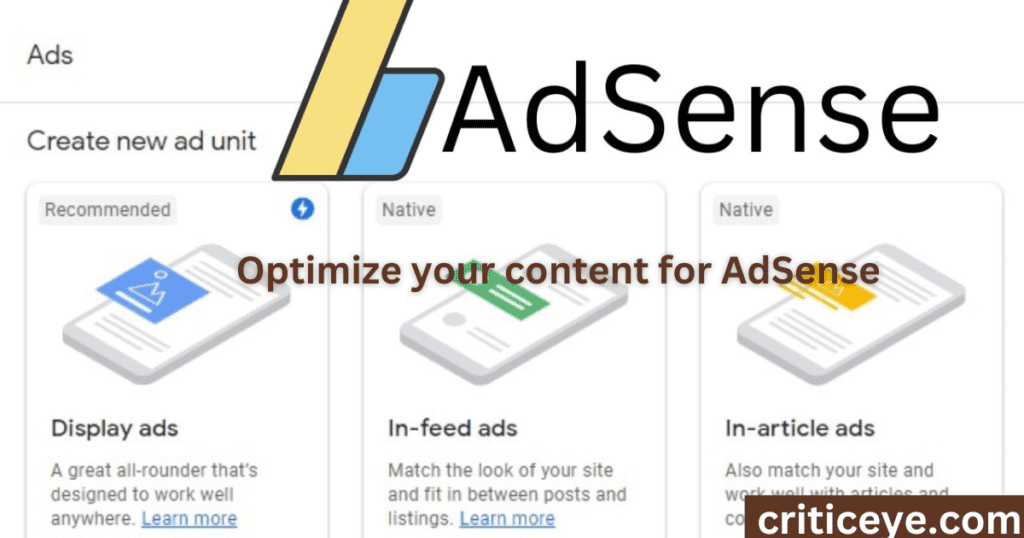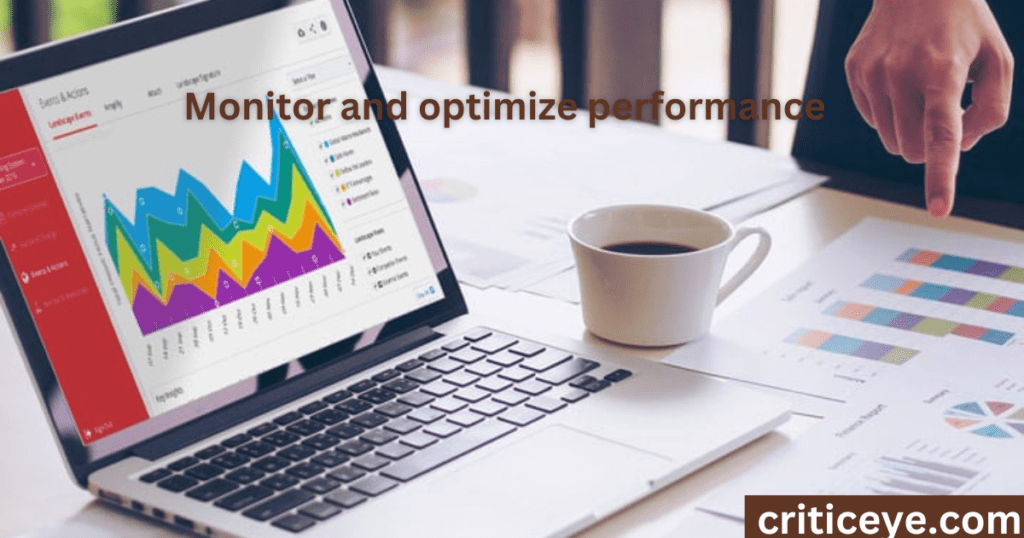How to earn $100 a day with Google AdSense

Online income generation has grown in popularity, with Google AdSense being one of the most well-known platforms. Earning $100 a Day with Google Adsense Website owners and content producers can monetarily support their online presence and create a steady flow of income by utilizing Google’s advertising infrastructure. We’ll talk about practical methods in this blog post to assist you in reaching your daily revenue target of $100 from Google AdSense.
1: Build a quality website or blog:

A well-designed and excellent website or blog is the cornerstone of every successful AdSense campaign. Your material ought to be worthwhile, interesting, and pertinent to the people you want to reach. Concentrate on a certain area of expertise or subject matter that you are enthusiastic about, and make sure your website is aesthetically pleasing, easy to use, and intuitive.
2: Optimize your content for AdSense:

It’s essential to optimize your content for ads if you want to maximize your AdSense earnings. Write blog entries and articles that are optimized for search engines (SEO) and packed with keywords to draw in natural visitors. Find prominent search terms associated with your niche by conducting keyword research, then carefully integrate those terms into your content. You will be more likely to draw in relevant advertising that has greater click-through rates if you do this.
3: Ad placement and format:

The secret to maximizing your AdSense revenue is strategic ad placement. Try out various ad locations and types to see what suits your audience and website the best. Think about putting advertisements within the content, near the conclusion of articles, and above the fold—the area of a webpage that is viewable without scrolling. To make your adverts seem less invasive and more natural, effortlessly integrate them into the general layout of your website.
4: Increase website traffic: (Earning $100 a Day with Google Adsense)

Getting a lot of people to visit your website is essential if you want to make a good living from AdSense. Put into practice successful digital marketing techniques including content promotion, social media marketing, and search engine optimization (SEO). To draw people to your website, make use of email marketing, social media, guest blogging, and other strategies. Your chances of getting clicks on your adverts increase with the amount of visitors you bring in.
5: Monitor and optimize performance:

Analyze the information offered in your AdSense account to keep a regular eye on your AdSense performance. Determine which advertisements are doing well or poorly. Based on the new insights, modify the types, locations, and formats of the advertisements. By using A/B testing, you may determine what your audience responds to the most and adjust your ad revenue appropriately.
6: Focus on high-paying keywords: (Earning $100 a Day with Google Adsense)

Because some keywords get greater advertising bids, they bring in more money with each click. Do some research, find some high-paying keywords that are related to your content, and carefully include them. You may uncover profitable keywords to boost your earnings by using tools like SEMrush or Google Keyword Planner.
7: Experiment with Adsense features: (website income per day)

You can maximize the performance of your ads by using the capabilities and resources that Google AdSense provides. To identify extra revenue streams, investigate features like responsive advertisements, matching content, auto ads, and link units. But be careful—overcrowding your website with advertisements might have a bad effect on user experience and engagement levels.
Build a quality website or blog: (how much traffic required for adsense approval in blogger)

Creating a high-quality blog or website is essential to optimizing your Google AdSense revenue. In addition to drawing more visitors, a well-designed and user-friendly website encourages people to interact with the adverts and your content. When creating your website or blog, keep the following crucial stages in mind:
- Determine Your specialty: Pick a specialty or subject area in which you are knowledgeable and have a strong interest. You can draw in a more focused audience and offer them insightful and pertinent content by focusing your attention. Additionally, it helps marketers show advertising that is relevant to your specialty, which raises the possibility of higher click-through rates.
- Select a Reputable Web Hosting Company: Choose a trustworthy hosting company that provides consistent uptime, server performance, and customer service. A website that loads slowly or is frequently unavailable might result in a bad user experience and decreased engagement. Select a hosting package whose storage, bandwidth, and scalability satisfy the needs of your website.
- User-Friendly Design: Make sure the layout and appearance of your website are clear and easy to use. It should be simple to navigate, well-organized, and clean. Make your color palette look appealing and select readable typefaces. Think about the entire user experience and ensure that users can easily and quickly find the information they require.
- Mobile Responsiveness: Having a website that is responsive to mobile devices is crucial since more and more people are accessing the internet via these devices. Make sure the layout and style of your website can adjust to various screen sizes and resolutions. To guarantee that mobile users have a flawless experience, test your website across a range of devices.
- High-quality Content: Produce valuable, unique, and high-quality content that appeals to your target audience. Devote time and energy to conducting thorough research and crafting excellent blog entries, films, essays, and other types of material. Use pertinent keywords wisely to increase your website’s exposure in search results and draw in natural traffic.
- Use search engine optimization (SEO) strategies to raise the visibility of your website in search engine results. Find suitable keywords by conducting keyword research, then organically include them in your writing. Improve the meta tags, headlines, URLs, and alt tags for your images. Make sure your website contains pages that load quickly, a sitemap, and an appropriate site structure.
- engaging Visuals: To improve the overall appeal of your website, use high-quality photos, videos, infographics, and other visual elements. Visitors are more likely to interact with your ads when they are engaged and stay on your site longer when you have visual content.
- Unambiguous Call-to-Action and Navigation: Ensure that the navigation options on your website are easy to understand and navigate. To make it simple for users to explore your information, including a prominent search bar, menu links, and pertinent categories or tags. Furthermore, use call-to-action buttons or links in strategic places to nudge visitors to complete desired actions, including subscribing to newsletters or clicking on suggested content.
- Frequent Updates: To keep users coming back for more, update your website frequently with new and pertinent material. In addition to improving search engine results, this lets marketers know that your website is lively and interesting, which could draw in higher-quality advertisements.
- Track Website Performance: Using analytics software such as Google Analytics, track your website’s performance regularly. Keep an eye on data like user engagement, bounce rates, page views, and traffic sources. You can maximize the functionality of your website and AdSense revenue by analyzing this data to find areas for development and make wise decisions.
Recall that creating a high-quality website or blog requires time and work. To build a platform that draws users and advertisers alike, concentrate on adding value to your audience, enhancing user experience, and continuously improving your content and design.
Optimize content for AdSense: (how to make money online with Google for free)

To get the most out of your platform earnings, you must optimize your content for AdSense. You can raise the possibility of greater click-through rates and improve income by carefully integrating AdSense advertising into your content. The following advice will assist you in AdSense content optimization:
- Relevant and Interesting Information: Produce insightful, worthwhile, and interesting information that appeals to your target market. Put your attention on informing, resolving issues, or amusing your audience. Longer visitor stays on your website increase the likelihood of ad interactions; this is especially true for more compelling content.
- Find popular and pertinent terms in your niche by conducting keyword research. You may find keywords with large search volumes and less competition by using tools like Ahrefs, SEMrush, and Google Keyword Planner. Naturally include these keywords into your content to increase search engine exposure and drive visitors from organic sources.
- Content Organisation: Make sure your writing is logically organized and easy to read. To make your text easier to scan, use bullet points, subheadings, and headings. This not only makes your information easier to read but also makes it easier for search engines to comprehend.
- Strategic Ad Placement: Try out several ad locations to see which ones are most effective for your audience and website. Think about putting advertisements within the content, after articles, or above the fold (visible without scrolling). Because they are more likely to capture the reader’s attention, ads that are positioned within paragraphs or close to the primary content typically perform better.
- Integrate adverts with the Design: To appear more natural and less invasive, integrate your adverts into the design of your website. To create a unified visual experience, use the same color scheme, font style, and size as the content on your website. To adhere to AdSense guidelines, make sure the advertisements can still be distinguished from the rest of the content.
- Choose Your Ad Format: Google AdSense provides a range of ad types, including text, display, responsive, and native ads. Try out several formats to see which ones work best for your website. Responsive ads can automatically change to match the available area, improving user experience on a variety of devices.
- Ad Unit Customisation: Make the most of AdSense’s customization features to enhance the look of your advertising. Try experimenting with different ad sizes, colors, borders, and fonts to see what works best in terms of aesthetic appeal and effectiveness. Make sure, nevertheless, that the customization enhances user experience rather than detracts from the general style of your website.
- AdSense Auto Ads: Take into consideration utilizing AdSense Auto Ads, which automatically position and optimize advertisements on your website using machine learning. Auto advertising can determine the ideal places to display advertising with just one line of code, which eliminates the need for human placement and increases the likelihood of higher revenue.
- Ad Performance Monitoring: Using the information in your AdSense account, keep a regular eye on how well your AdSense advertisements are doing. Examine measures like earnings per click (EPC), cost per click (CPC), and click-through rate (CTR). Determine which advertisements are successful and which are not. Make wise choices regarding ad placement, format, and optimization tactics by using this data.
- Evaluate and Rework: Always experiment with numerous ad forms, locations, and tactics to determine what works best for your website. Compare many iterations of your content or ad placements to see which ones yield better results. This is known as A/B testing. To gradually increase the performance of your AdSense account, make little adjustments based on the knowledge you have obtained from your testing.
Recall that maintaining a balance between the user experience and ad placement is just as crucial as optimizing your content for AdSense. As this will eventually result in more engaged visitors and higher AdSense earnings, give priority to producing valuable content and offering a positive user experience.
Ad placement and format: (ways to earn from Google adsense)

Optimizing the location and type of your ads is essential to increasing your AdSense revenue. Ads are visible to visitors without being too obtrusive thanks to strategic placement, and the appropriate ad styles increase click-through rates by catering to user preferences. The following advice can help you maximize ad placement and format for improved outcomes:
- Above-the-Fold Placement: Advertisements that are positioned above the fold, or the area of a page that is viewable without scrolling, typically draw in more visitors. For maximum exposure and ad impressions, think about putting a leaderboard or a medium rectangular ad unit near the top of your website.
- Ads placed within your content, whether inline or in-content, can be a useful tool for drawing readers’ attention while they interact with your blog entries or articles. Advertisements should be inserted inside the text body or in between paragraphs to fit in organically with the content. Because people view these advertisements as integrated into the content, this placement frequently leads to increased click-through rates.
- Sidebar/Skyscraper Placement: Make use of your website’s sidebar space to showcase vertical ad units, such as skyscrapers or broad skyscrapers. This advertising might appear next to your original content to give viewers more exposure to pertinent ads. Try out various ad sizes and locations in the sidebar to determine where your website’s layout works best.
- End of Article Placement: An excellent technique to draw readers’ attention after they have completed reading is to include advertisements after your blog entries or articles. Because people are more inclined to interact with adverts after reading the primary content, a well-designed rectangle or large rectangle ad unit placed at the end of the article can result in increased click-through rates.
- Responsive ad units should be used; they will automatically change in size and format to fit the available space on various devices. Your advertisements will appear visually appealing and function correctly on desktop, tablet, and mobile devices when they are responsively designed. This strategy can boost overall ad performance while also improving user experience.
- Native Ad Formats: Rather than looking like typical commercials, native ads are made to fit in perfectly with the design and feel of your website. Because these advertisements provide a seamless and non-disruptive user experience, they frequently result in increased engagement and click-through rates. Try out several native ad forms, like matching content units or in-feed advertisements.
- Try Different Ad Sizes: There are several ad sizes available with Google AdSense, such as leaderboard (728×90), medium rectangle (300×250), and huge skyscraper (300×600). Try out various ad sizes to determine which ones bring in the most money and click-through rates for your website. While choosing ad sizes, take into account the available space, user preferences, and the design of your web pages.
- Mobile Optimisation: It’s critical to optimize your ad placement and format for mobile consumers, as the number of people using mobile devices for internet browsing continues to rise. Make sure your advertisements work well on tiny screens and are responsive to mobile devices. To give mobile visitors a smooth ad experience, think about utilizing responsive ad units or mobile-specific ad formats.
- Ad Balance: While increasing ad impressions is crucial, you shouldn’t overcrowd your website with adverts. Overuse of advertisements can detract from the user experience by increasing bounce rates and decreasing engagement. Strike a balance between the exposure of the ads and a simple, user-friendly design that puts the needs of the user first.
- Frequent Optimisation and Testing: Make use of the information in your AdSense account to track the effectiveness of your ad styles and locations over time. Examine data like ad viewability, profits per click, and click-through rates. To find the best combinations, compare various placements or formats and conduct A/B testing. Ad strategy should be optimized based on data-driven judgments.
Recall that determining the best ad location and structure is a process that calls for analysis, adaptation, and experimentation. Achieving a balance between optimizing revenue and upholding a great user experience is essential. Make sure that your advertisements complement, rather than take away from, the content on your website.
Increase website traffic: (how much we can earn from google adsense)

Getting more people to visit your website is crucial to optimizing your Google AdSense revenue. The likelihood of ad impressions and clicks increases with the number of visitors to your website. The following are some practical methods to assist you in boosting website traffic:
- Optimize your website for search engines (SEO) by including pertinent keywords in your headings, meta descriptions, content, and URLs. Concentrate on producing valuable, high-quality material that complies with user search intent. Ensure that your website is properly structured, speed up its loading times, and make it mobile-friendly. SEO raises your content’s organic ranks and increases its visibility by assisting search engines in determining the relevancy and caliber of your writing.
- Marketing using Content: Produce and disseminate informative material that speaks to your intended audience. Post articles, movies, infographics, blog entries, and other types of information that are entertaining, informative, or offer solutions. To boost exposure and improve traffic to your website, share your material on social media, take part in pertinent online forums, and interact with your audience.
- Social Media Marketing: Make the most of social media channels to draw traffic to your website and advertise your content. Make profiles on well-known social media sites, such as Pinterest, LinkedIn, Instagram, Twitter, and Facebook. Distribute your material, interact with readers, and create a brand community. To reach a larger audience and increase website traffic, work with influencers, launch targeted advertising campaigns, and use relevant hashtags.
- Email marketing: Create an email list and subscribe to it by sending out newsletters or updates regularly. Encourage individuals to sign up by offering promos, special material, or helpful resources. By sending subscribers to your website to read new blog articles, take advantage of special deals, or take part in events or contests, you may use email marketing to increase traffic.
- Writing excellent guest posts for respectable websites in your niche is known as guest blogging. A bio or author box with a backlink to your website should be included. In addition to expanding your audience, guest blogging builds your authority and directs visitors from other websites to your own.
- Influencer marketing: Assist prominent figures in your field who have a sizable fan base. Collaborate with them to produce content, arrange podcasts or webinars, or advertise your goods and services. Influencers have the power to expose your website to their audience, which will boost traffic, legitimacy, and visibility.
- Online Advertising: To increase targeted visitors to your website, think about launching online advertising campaigns. You may target audiences with ads on Google Ads, Facebook Ads, LinkedIn Ads, and other platforms based on their demographics, interests, and behaviors. Make use of attention-grabbing images and persuasive ad language to entice clicks and direct traffic to your website.
- Work Together with Others: To cross-promote each other’s material, and collaborate with other website owners or content producers in your niche. This can involve writing blog entries together, collaborating to produce podcasts or webinars, or highlighting one another in feature stories or interviews. You can increase your reach and access new traffic sources by making use of each other’s audiences.
- Optimise for Social Sharing: By including social sharing icons on your website, you can make it simple for people to share your material. Add a call-to-action to your articles or blog entries to entice people to share them. Your material might increase in visibility and traffic the more times it is shared on social media.
- Examine and Improve: Use tools such as Google Analytics to analyze website traffic regularly. Determine which material is the most popular, where your traffic is coming from, and how your visitors are acting. Utilize this information to enhance your content strategy, spot areas for development, and optimize your website to draw in and keep more users.
Recall that growing a website’s traffic requires patience and persistent work. To draw specific visitors to your website, concentrate on offering helpful information, establishing a rapport with your audience, and utilizing a variety of marketing techniques.
Monitor and optimize website traffic: (google earning website)

To maximize your earnings and enhance the user experience overall, you must track and optimize the performance of your website and Google AdSense advertising. The following are essential actions to track and improve the functionality of your website:
- Install a powerful analytics program on your website, like Google Analytics, to begin setting up analytics. You will gain important knowledge about bounce rates, popular pages, traffic sources, visitor behavior, and more from this. To track particular objectives, such as ad clicks, form submissions, or purchases, set up conversion tracking.
- Monitor AdSense Results: Make use of the reporting tools in your Google AdSense account to keep an eye on the effectiveness of your advertisements. Examine data points including overall revenue, page RPM (revenue per thousand impressions), earnings per click (EPC), and click-through rate (CTR). Determine trends, patterns, and opportunities for improvement by analyzing the data.
- Do A/B Testing: A/B testing allows you to compare various iterations of your website or ad placements. Test elements like call-to-action buttons, ad sizes, colors, and placements. Through concurrent performance testing, you can determine which iterations yield superior outcomes and use data-driven decision-making to optimize your advertisements.
- Optimise Ad Placement: Try a variety of ad locations on your website to determine which ones will bring in the most clicks and money. To determine the places where users often concentrate their attention, think about utilizing heat map techniques. Put advertisements there where they will be seen by many people, but make sure the whole user experience is balanced.
- Boost Website Speed: User engagement and bounce rates can both rise from a slow-loading website. Use tools like GTmetrix or Google PageSpeed Insights to regularly check the speed of your website. To speed up the loading of your website, minimize code, optimize pictures, turn on caching, and make use of content delivery networks (CDNs).
- Mobile Optimisation: It’s imperative to optimize your website and advertisements for mobile users, given the growing prevalence of mobile devices. Make sure your advertising displays correctly on different screen sizes and that your website is responsive to mobile devices. To offer a flawless mobile experience, test your website on various hardware and browser combinations.
- User Experience Enhancement: Concentrate on making your website’s user experience better overall. Assure simple calls to action, intuitive design, and easy navigation. Make your material as readable and scannable as possible. Ensure that your website is user-friendly and accessible to people with impairments. Increased ad interactions, longer page views, and higher engagement are all results of a positive user experience.
- Content optimization: Make constant improvements to your material in response to data insights and user engagement. Using analytics, determine which of your themes and content are the most popular, then focus your future content creation efforts on those areas of interest. To increase your website’s visibility in search results, naturally include pertinent keywords. To keep already-existing information interesting and engaging, update and repurpose it.
- Track Ad Blocking: Keep an eye out for and take action against any instances of ad blocking occurring on your website. Ad blocking affects your ad impressions and revenue, even though it’s important to respect people’s wishes. Take into account using anti-adblocking software or interacting with users to promote whitelisting your website.
- Keep Up With It and Adjust: Keep up with AdSense policy changes, industry best practices, and the most recent developments. Visit the Google AdSense Help Centre frequently and take part in pertinent communities or forums. To make sure you’re optimizing your ad performance, make adjustments to your strategy and optimizations in light of fresh facts.
Your website’s performance and ad placements may be regularly monitored and optimized to help you find areas for development, make data-driven decisions, and increase your earnings from Google AdSense all the while giving your visitors a better experience.
Conclusions: (Earning $100 a Day with Google Adsense)
In conclusion, achieving a consistent income of $100 a day with Google AdSense requires a strategic and diligent approach. This journey involves creating high-quality, engaging content, optimizing ad placements, and adhering to Google’s policies. Patience is key, as building a substantial audience and maximizing ad revenue takes time. Regularly analyzing performance metrics, experimenting with different strategies, and staying informed about industry trends are essential components of success. While earning $100 a day is an ambitious goal, it is attainable with dedication, continuous learning, and a commitment to providing value to your audience. Remember, success in the realm of Google AdSense hinges on a combination of quality content, user engagement, and smart optimization strategies.







